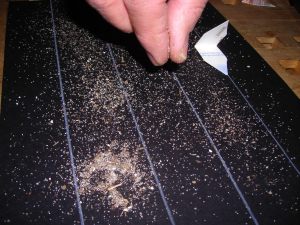
Clio supplemento a Argonauta n. 7-12 2011
 |
 |

Selezionare il detrito
Una volta portato in casa il detrito potrai estrarre con calma le conchiglie. Anche qui ti verrà l'impulso di raccogliere nel contenitore le conchiglie che vedi e...resterai sempre con il dubbio che li dentro ci possano essere ancora altre conchiglie sfuggite alla tua vista. Procediamo con calma e metodo: munisciti di un cartoncino nero delle dimensioni di un foglio di carta e traccia su di esso delle righe con una matita da disegno bianca. Sarà bene distanziarle di circa 4-5 centimetri. Disponi sul tavolo il tuo foglio nero e spargici sopra un "pizzico" di detrito. Ora raccogli con una "pinzetta" tutto ciò che ti "sembra" essere conchiglia, solo dopo e magari sotto un microscopio, farai una analisi più attenta. Procedi però esaminando una striscia per volta, quelle che hai delimitato con la matita bianca, dall'alto verso il basso e da un lato verso l'altro. Non passare mai alla striscia successiva, fai finta che non esista, senza aver completamente esaminato quella attuale. Alla fine sarai sicuro di aver raccolto "tutte" le conchiglie e potrai gettare quanto rimasto sul foglio spargendoci sopra un altro pizzico di detrito.  Realizza le "pinzette" con il cartoncino delle scatole che vengono messe da una parte per il riciclaggio. Piega il cartoncino in due e ritaglia con le forbici una forma simile a quella della foto. Queste pinzette sono "usa e getta": nel momento che non hanno più la "presa" desiderata, si gettano e se ne ritaglia una nuova. Con queste pinzette, piuttosto morbide, non distruggerai le conchiglie più delicate e fragili. |
To select the detritus
Once brought into the house the detritus you can remove slowly shells. Here too you will be the impetus to collect in the container the shells you see ... you'll be always with them in doubt that there may still be other shells escaped your sight.  Proceed calmly and methodically: arm yourself with a black card with the size of a sheet of paper and trace the lines on it with a white drawing pencil. It will be well to open it as wide of about 4-5 cm. Arrange your black sheet on the table and scatter above a "pinch" of detritus. Now pick with a "tweezer" all what you "seems" to be shell, after and even under a microscope, you will do a more careful analysis. Proceed, however, by examining a strip at a time, those which have delimited with the white pencil, from top to bottom and from one side to the other. Never go to the next strip, pretend that there is, without having fully examined the current one. At the end you're sure to have collected "all" and you can throw the shells remained on the paper and scattering above another pinch of detritus. Build the "tweezers" with cardboard boxes that are put to one side for recycling. Fold the cardboard in half and cut with scissors a form similar to that of the photo. These tweezers are "disposable" when you no longer have the "grip" you want, you throw and you cut a new one. With these tweezers, rather soft, not destroy the most delicate and fragile shells. |
